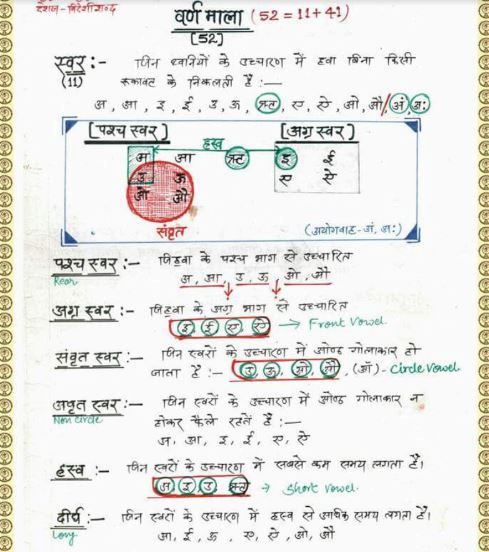‘सामान्य हिंदी हस्तलिखित Note’ PDF Quick download link is given at the bottom of this article. You can see the PDF demo, size of the PDF, page numbers, and direct download Free PDF of ‘General Hindi Handwritten Note’ using the download button.
हस्तलिखित हिंदी नोट – Handwritten Hindi Note With PDF Free Download

हिंदी हस्तलिखित नोट्स
लिपि लिखने का अभ्यास
The shape of each letter, and how to write it correctly by hand, is best learned in a step-by-step approach, as presented below.
The practice space has been tailored especially for beginner Hindi writers.
You can begin by tracing each letter and then proceed to write the letter independently in the space provided. Repeat this process until you develop fluency.
Note that several of the Hindi vowels vary only slightly from each other in their shapes.
For example, six out of the thirteen vowels consist of additions made to the first vowel अ (a).
It is important to recognize the differences between them. In some cases, variation also exists between the handwritten and print forms.
For example, the dots and hooks on the top and side of letters look fairly similar in the handwritten and print versions; however, some marks on top, such as on ऐ, ओ, and औ tend to have an open loop (like a balloon) in the handwritten version.
Stark differences in print and handwritten are mentioned where applicable.
At this early stage, the time and practice dedicated to carefully forming the shape of each letter and associating it with its unique sound will pay off in the long run.
This knowledge provides a solid foundation for better Hindi reading and writing ability.
Consonants व्यंजन
The chart below includes the traditional thirty-eight consonant sounds and the six additional consonants that occur in the modern Hindi language.
As a memory aid, the consonant sounds are presented in vertical and horizontal groups, according to how they are produced.
Vertically, the consonant sounds alternate between unaspirated and aspirated versions and end with a
nasal form.
For instance, in the first row in the chart below, the first consonant क (ka) is unaspirated, which means that it is pronounced without a puff of air accompanying it.
The second consonant ख (Kha) is aspirated, which means that it is pronounced with a puff of air.
The third consonant ग (ga) is again unaspirated, followed by the fourth aspirated one घ (gha).
This pattern is applicable to the first five rows.
Two of the nasals in the chart appear in braces, as they are extremely rare in use.
एक नज़र हिंदी के व्जनों पर
Horizontally, the vowels are grouped according to the part(s) of the human speech organs from which these sounds are generated—the throat, palate, tongue, teeth, and lips.
Velar consonants in the first row are produced at the back of the tongue, in the throat.
In the second row, palatal consonants are generated using the front of the tongue and the palate.
Retroflex consonants in the third row are created by folding the tongue to touch the palate and then flipping it forward.
Dental consonants in the fourth row are produced by the tongue touching the teeth from the inside.
In the fifth row, labial consonants are generated using the lips.
Semivowels in the sixth row are vowel-like consonants.
In the seventh row, sibilants are created using a hissing sound that releases air from the mouth.
Finally, in the eighth row, the single aspirate or glottal is produced with a puff of air.
Row A contains retroflex versions of some consonants that have been presented previously in row 3, but occur in a form that is dotted at the bottom.
The dot adds a rolling “r” to the existing sound. In row B, five dotted versions of the previously presented consonants are shown.
These have been adapted from Perso-Arabic and create slightly different sounds.
Row C has combination characters that have two sounds within one letter.
These have been adapted from Sanskrit.
A more detailed pronunciation guide follows.
उच्चारण
The IAST phonetic symbols are given below for each consonant.
Sounds and pronunciation examples in English are also provided to further distinguish between certain sounds that seem similar when romanized but are in fact different in Hindi.
For example, the vowel ऋ and the consonant ड़ are both symbolized as “r..” In Hindi pronunciation, however, the vowel ऋ is pronounced “re” (as in react) and ड़ is closer to “rda” (as in hardy).
You may also notice that the sounds in English that have been provided contain an extra “a” at the end of the consonant (ka, kha, ga, etc.).
This is because the vowel अ (a) is considered a part of each consonant.
This information is important to remember when reading the transliteration and in forming and making a distinction between certain Hindi words later
| लेखक | – |
| भाषा | हिन्दी |
| कुल पृष्ठ | 88 |
| PDF साइज़ | 10 MB |
| Category | Book |
| Source/Credits | drive.google.com/ |
हस्तलिखित हिंदी नोट – Handwritten Hindi Note With PDF Free Download
